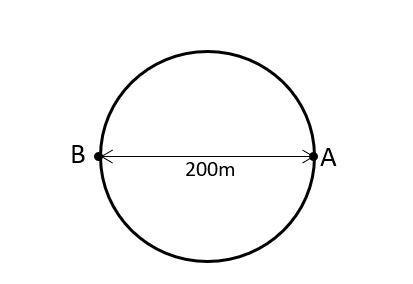
An athlete completes one round of a circular track of diameter 200m in 40s. What will be the distance covered and the displacement at the end of 2 min 20s?
Answer
586.2k+ views
Hint: We will first find the length of track using the diameter given. Then, we will find out the velocity of the athlete with the time given to complete one round of the track. Then from the time given, we will find out the final position of the athlete and that will help us to find the distance and displacement.
Complete step by step solution:

Let us assume that initially the athlete is at point A on the track.
Now, according to the question, the radius of the circular track, R = 100m.
Therefore, total length of the track $=2\pi R=200\pi$
Now, it is given that the time taken to complete one round of the circular track by the athlete = 40s.
Thus, the speed of the athlete $=\dfrac{200\pi}{40}=5\pi$ m/s.
Therefore, in 2 min 20s or 140s, the distance travelled by the athlete will be $=5\pi \times 140=700\pi$ m.
Thus, on completion of the journey, the athlete will be covering three rounds of the circular track and $100\pi$m i.e. half of the track length and will reach at a point diametrically opposite to the point B.
We know that the displacement of an object is the shortest distance between the initial and final positions.
Thus, here the shortest distance between the points A and B will be the same as that of the diameter, 200m.
Hence, distance covered will be $700\pi$m and displacement will be 200m.
Note: There can be a mistake that one may take the displacement as the semi-perimeter of the track. We can also find the final location of the athlete by finding the number of rounds the athlete can make by dividing the time given by the time taken in one revolution.
Complete step by step solution:

Let us assume that initially the athlete is at point A on the track.
Now, according to the question, the radius of the circular track, R = 100m.
Therefore, total length of the track $=2\pi R=200\pi$
Now, it is given that the time taken to complete one round of the circular track by the athlete = 40s.
Thus, the speed of the athlete $=\dfrac{200\pi}{40}=5\pi$ m/s.
Therefore, in 2 min 20s or 140s, the distance travelled by the athlete will be $=5\pi \times 140=700\pi$ m.
Thus, on completion of the journey, the athlete will be covering three rounds of the circular track and $100\pi$m i.e. half of the track length and will reach at a point diametrically opposite to the point B.
We know that the displacement of an object is the shortest distance between the initial and final positions.
Thus, here the shortest distance between the points A and B will be the same as that of the diameter, 200m.
Hence, distance covered will be $700\pi$m and displacement will be 200m.
Note: There can be a mistake that one may take the displacement as the semi-perimeter of the track. We can also find the final location of the athlete by finding the number of rounds the athlete can make by dividing the time given by the time taken in one revolution.
Recently Updated Pages
Master Class 11 Economics: Engaging Questions & Answers for Success

Master Class 11 English: Engaging Questions & Answers for Success

Master Class 11 Social Science: Engaging Questions & Answers for Success

Master Class 11 Biology: Engaging Questions & Answers for Success

Class 11 Question and Answer - Your Ultimate Solutions Guide

Master Class 11 Business Studies: Engaging Questions & Answers for Success

Trending doubts
10 examples of friction in our daily life

One Metric ton is equal to kg A 10000 B 1000 C 100 class 11 physics CBSE

Difference Between Prokaryotic Cells and Eukaryotic Cells

1 Quintal is equal to a 110 kg b 10 kg c 100kg d 1000 class 11 physics CBSE

State the laws of reflection of light

Explain zero factorial class 11 maths CBSE




